 To enhance service speed and avoid tariff delays, we've opened a US warehouse. All US orders ship directly from our US facility.
To enhance service speed and avoid tariff delays, we've opened a US warehouse. All US orders ship directly from our US facility.
| Cat. No. | Product Name | Field of Application | Chemical Structure |
|---|---|---|---|
| DC44907 | SRS11-92 Featured |
SRS11-92, a Ferrostatin-1 (Fer-1) analogue, is a potent ferroptosis inhibitor. SRS11-92 inhibits ferroptotic cell death induced by Erastin in HT-1080 human fibrosarcoma cells (EC50=6 nM).
More description
|

|
| DC22001 | AS-1269574 Featured |
AS-1269574 is a selective, orally available GPR119 agonist with EC50 of 2.5 uM in cell-based cAMP assays.
More description
|

|
| DC33650 | IUN76750 Featured |
UTL-5g is a novel potential chemoprotective agent, TNF-α inhibitor that reduces cisplatin-induced side effects including nephrotoxicity, hepatotoxicity and hematotoxicity. It lowers elevated levels of AST, ALT, creatinine, BUN, and TNF-α, increases the reduced platelet count in mice, and acts as a novel chemo- and radioprotective agent.
More description
|

|
| DC21041 | UTL-5g Featured |
UTL-5g (GBL-5g) is a novel potential chemoprotective agent, TNF-α inhibitor that reduces cisplatin-induced side effects including nephrotoxicity, hepatotoxicity and hematotoxicity.
More description
|

|
| DC34366 | m-3M3FBS Featured |
m-3M3FBS is an activator of phospholipase C (PLC). It acts by stimulating superoxide generation, Ca2+ release and inositol phosphate formation in a variety of cell types.
More description
|

|
| DC66302 | PKC-theta inhibitor hcl Featured |
PKCθ inhibitor is an inhibitor of PKCθ.
More description
|

|
| DC43147 | FIPI hydrochloride Featured |
FIPI (5-Fluoro-2-indolyl des-chlorohalopemide) hydrochloride, a derivative of Halopemide (HY-119093), is a phospholipase D (PLD) inhibitor with IC50s of approximately 25 nM and 20 nM for PLD1 and PLD2, respectively. FIPI hydrochloride inhibits PLD regulation of F-actin cytoskeleton reorganization, cell spreading, and chemotaxis. FIPI hydrochloride has the potential for autoimmunity and cancer metastasis research.
More description
|
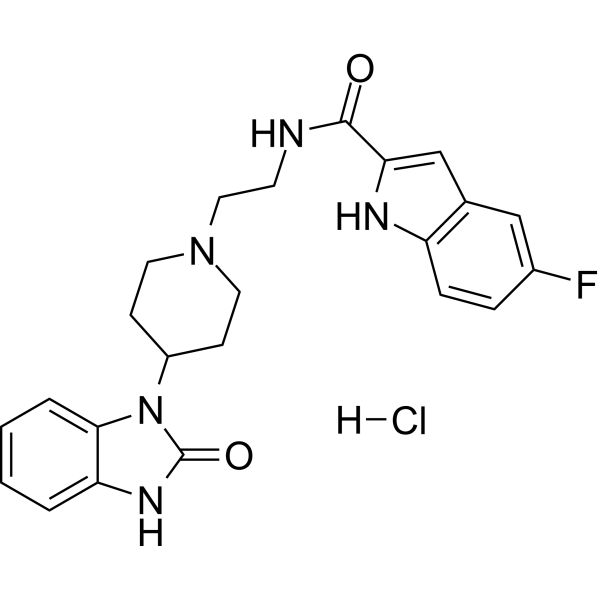
|
| DC66301 | WHI-P97 HCl Featured |

|
|
| DC23499 | BD-1047 Featured |
BD-1047 is a potent, selecitve Sigma 1 receptor (σ1) antagonist with Ki of 0.93 nM.
More description
|

|
| DC42521 | MBCQ Featured |
MBCQ is a potent and selective the type V phosphodiesterase (PDE V; PDE5) inhibitor with an IC50 of 19 nM. MBCQ has IC50s >100 µM for PDE1, PDE2, PDE3, and PDE4, respectively. MBCQ dilates coronary arteries via potent and specific inhibition of cGMP-PDE.
More description
|

|
| DC66300 | ZM-306416 HCI Featured |
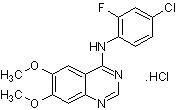
|
|
| DC9256 | KS176 Featured |
KS176 is a potent and selective inhibitor of the breast cancer resistance protein (BCRP) multidrug transporter (IC50 values are 0.59 and 1.39 μM in Pheo A and Hoechst 33342 assays respectively). Displays no inhibitory activity against P-gp or MRP1.
More description
|

|
| DC32402 | Fatostatin A Featured |
Fatostatin A is a Cell permeable inhibitor of SREBP activation. Fatostatin Inhibits Cancer Cell Proliferation by Affecting Mitotic Microtubule Spindle Assembly and Cell Division. Fatostatin suppresses growth and enhances apoptosis by blocking SREBP-regulated metabolic pathways in endometrial carcinoma.
More description
|
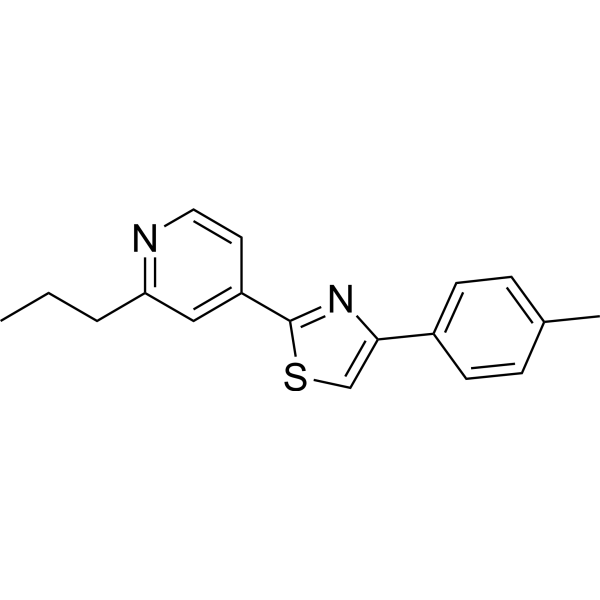
|
| DC21826 | XE-991 Featured |
XE-991 is a potent, selective and orally active blocker of voltage-gated potassium channels Kv7 (KCNQ) that blocks KCNQ1, KCNQ2 and KCNQ2+KCNQ3 with Kd of 0.78, 0.7 and 0.6 uM, respectively.
More description
|
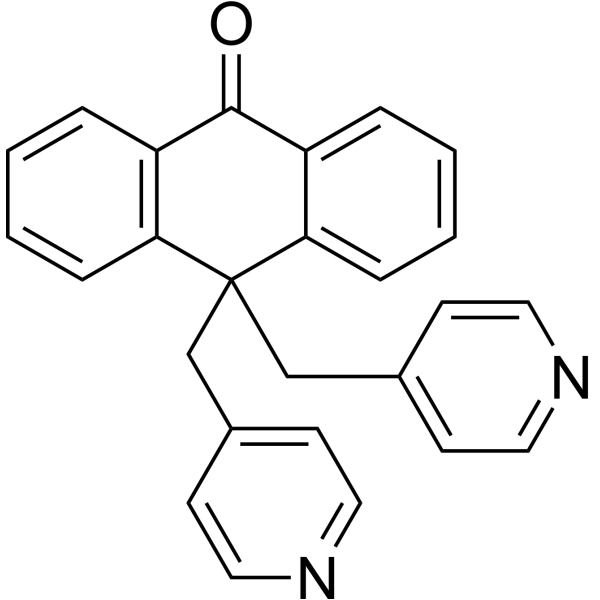
|
| DC31251 | Quisinostat HCl Featured |
Quisinostat, also known as JNJ-26481585, is an orally bioavailable, second-generation, hydroxamic acid-based inhibitor of histone deacetylase (HDAC) with potential antineoplastic activity. HDAC inhibitor JNJ-26481585 inhibits HDAC leading to an accumulation of highly acetylated histones, which may result in an induction of chromatin remodeling; inhibition of the transcription of tumor suppressor genes; inhibition of tumor cell division; and the induction of tumor cell apoptosis. HDAC, an enzyme upregulated in many tumor types, deacetylates chromatin histone proteins. Compared to some first generation HDAC inhibitors, JNJ-26481585 may induce superior HSP70 upregulation and bcl-2 downregulation.
More description
|
.gif)
|
| DC12637 | Finerenone Featured |
Finerenone (BAY 94-8862) is a third-generation, selective, and orally available nonsteroidal mineralocorticoid receptor (MR) antagonist (IC50=18 nM). Finerenone displays excellent selectivity versus glucocorticoid receptor (GR), androgen receptor (AR), and progesterone receptor (>500-fold). Finerenone has the potential for cardiorenal diseases research, such as type 2 diabetes mellitus and chronic kidney disease.
More description
|
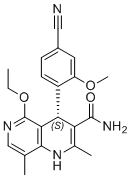
|
| DC49858 | Dodecyltrimethylammonium bromide Featured |
Dodecyltrimethylammonium bromide (DTAB) is a surfactant. Dodecyltrimethylammonium bromide interacts with DNA and changes the mechanical properties of DNA on binding and the specific binding parameters of the interaction.
More description
|
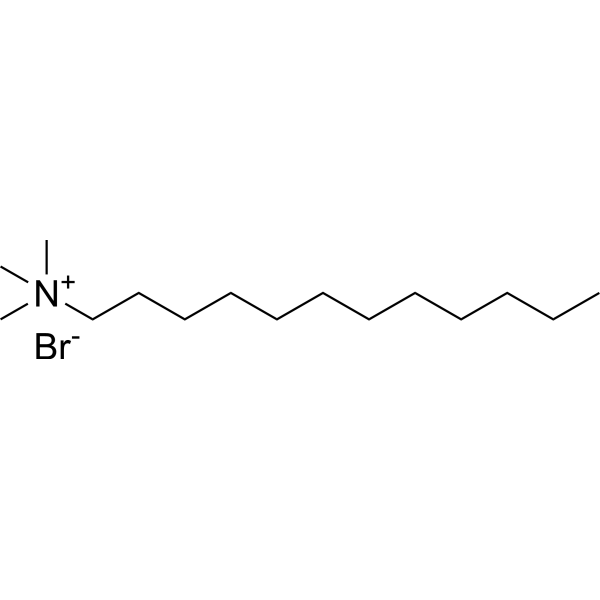
|
| DC41277 | Tetradecyltrimethylammonium bromide Featured |
Tetradecyltrimethylammonium bromide, an organic building block, is a cationic surfactant with asymmetrical structure.
More description
|

|
| DC66287 | Cetrimonium bromide Featured |
CTAB(Cetyltrimethylammonium bromide) is a quaternary ammonium surfactant commonly used in various fields such as chemistry, biology, and material science.
Structure: CTAB consists of a long hydrocarbon chain (cetyl group) attached to a positively charged nitrogen atom. The cetyl group provides hydrophobic properties to the molecule, while the positively charged nitrogen offers a hydrophilic head.
More description
|

|
| DC60529 | LY3473329 (Muvalaplin) Featured |
LY3473329 (Muvalaplin) is a potent, multivalent disruptor of lipoprotein(a) (Lp(a)). LY3473329-HCl binds to apolipoprotein KIV8 selectively with a potency of 22 nM and inhibits the formation of Lp(a) particles in vitro with IC50 of 0.09 nM.
More description
|
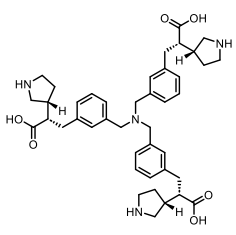
|
| DC73963 | DB2313 Featured |
DB2313 is a small-molecule transcription factor PU.1 inhibitor abrogating DNA binding by PU.1 with Kd of 29 nM.
More description
|

|
| DC71628 | WAY-340935 Featured |
WAY-340935 (VEGFR2-IN-2) can inhibit the function of VEGFR2 and the anti-proliferative activity against the H460 cell line is produced partly by interaction of VEGFR protein.
More description
|

|
| DC60595 | N3-PEG8-Lys(mmt)-APABOH Featured |

|
|
| DC60594 | PENTANAMIDE, 5-[(2,5-DIOXO-1-PYRROLIDINYL)OXY]-5-OXO-N-2-PROPYNYL- Featured |
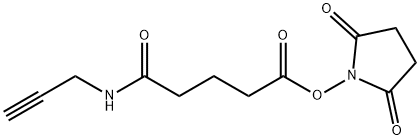
|
|
| DC60593 | Gly-Gly-Gly-VC-PAB-MMAE Featured |

|
|
| DC60592 | Fmoc-Val-Cit-PAB-MMAE Featured |
Fmoc-Val-Cit-PAB-MMAE consists the ADCs linker (Fmoc-Val-Cit-PAB) and potent tubulin inhibitor (MMAE). Fmoc-Val-Cit-PAB-MMAE is a agent-linker conjugate for ADC.
More description
|
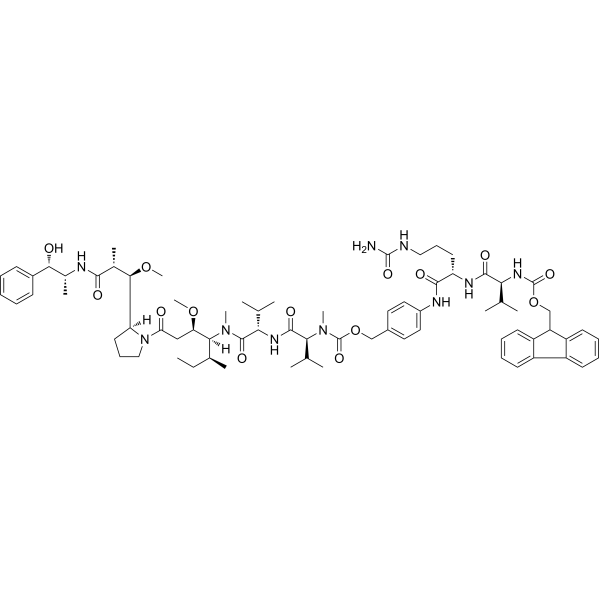
|
| DC66257 | DOPE-PEG-NPC Featured |
DOPE-PEG is a versatile phospholipid derivative with unique properties that make it suitable for various applications. Its hydrophobic and hydrophilic nature enables efficient encapsulation and delivery of drugs and nucleic acids, making it a valuable tool in drug delivery systems and gene therapy.
Additionally, DOPE-PEG can enhance the stability and circulation time of liposomes, improving their efficacy as drug carriers.
More description
|

|
| DC66256 | C18-PEG-DOPE DOPE-PEG-C18 Featured |
DOPE-PEG is a versatile phospholipid derivative with unique properties that make it suitable for various applications. Its hydrophobic and hydrophilic nature enables efficient encapsulation and delivery of drugs and nucleic acids, making it a valuable tool in drug delivery systems and gene therapy.
Additionally, DOPE-PEG can enhance the stability and circulation time of liposomes, improving their efficacy as drug carriers.
More description
|

|
| DC66255 | Acrylate-PEG-DOPE DOPE-PEG-Acrylate Featured |
Because the solubility parameters of polyacrylate and uncured epoxy resin have little difference, the two have good mutual solubility. And because the main chain of polyacrylate does not contain double bonds, it has a good thermal oxidation resistance.
Acrylate PEG derivatives can be used to modify proteins, peptides and other active group materials or small molecules.
Acrylate PEG derivatives can form hydrogels. Polyethylene glycol can increase solubility and stability. Reducing the immunogenicity of peptides and proteins, it can also inhibit the non-specific binding of charged molecules on the modified surface.
More description
|

|
| DC66254 | DOPE-PEG-Ce6 Featured |

|